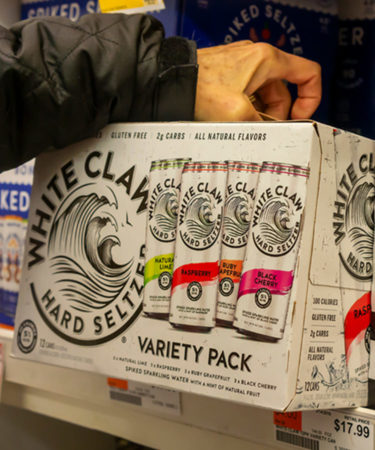It’s hard to escape the headlines declaring hard seltzers’ surging popularity, but the most recent sales figures offered by market research firms and those in the alcohol industry are nothing short of remarkable.
According to data provided by market research firm IWSR, hard seltzer sales rose to 82.5 million cases in 2019. The category now accounts for 2.6 percent of alcohol sales by volume in the U.S., according to IWSR’s chief operating officer Brandy Rand.
That doesn’t sound like a lot until you compare it to the volume shares of spirits and wine, which stand at 6.83 percent and 11 percent respectively. In other words, in just a few years, the hard seltzer category has grown to nearly half the size of spirits. What makes those figures even more astonishing is that hard seltzers accounted for less than 1 percent of volume sales in 2018.
By all accounts, hard seltzer’s remarkable growth looks certain to continue. The IWSR predicts it will triple by 2023 and cites convenience and low- alcohol and calorie contents as the reasons for its popularity.
Numerous brands are betting big on this continued growth. To help launch Corona Hard Seltzer this spring, Constellation Brands has budgeted $40 million for marketing alone. Meanwhile, White Claw, the category leader, recently revealed plans for a new $250 million production facility in Glendale, Ariz.
According to data provided by White Claw Hard Seltzer, the brand saw its dollar sales grow 304.3 percent in the 52 weeks ending January 5, 2020. That means it’s currently outpacing the growth of the overall beer category by nearly 300 percentage points. The brand says 40 percent of its gains have come from wine and spirits drinkers, with 10 percent coming from vodka alone.
Meanwhile, wine consumption in the U.S. declined in 2019 for the first time in 25 years. Though sparkling wine sales grew by almost 4 percent, it wasn’t enough to offset a decrease in the (much larger) still wine category, contributing to a 0.9 percent decrease overall, the IWSR says.
Surprisingly, the decline in wine consumption came during a year when overall alcohol sales grew 0.3 percent by volume. Further outpacing this growth was a 2.5 percent increase in the value of sales, which rose to $167 billion. According to Rand, this is “a clear indicator that U.S. consumers are willing to pay for more premium products.”
That, and they just can’t get enough of hard seltzers.
